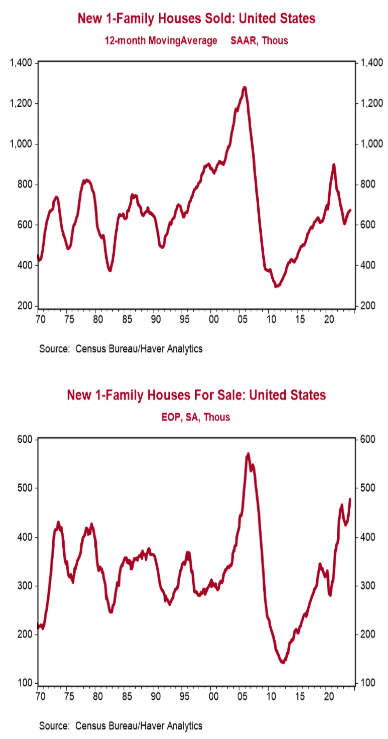- New single-family home sales increased 8.8% in March to a 0.693 million annual rate, beating the consensus expected 0.668 million. Sales are up 8.3% from a year ago.
- Sales in March rose in all the major regions.
- The months’ supply of new homes (how long it would take to sell all the homes in inventory) declined to 8.3 in March. The drop was entirely due to the faster pace of sales. Inventories increased by 12,000 units in March.
- The median price of new homes sold was $430,700 in March, down 1.9% from a year ago. The average price of new homes sold was $524,800, up 1.0% versus last year.
Implications: New home sales came in stronger than expected in March, driven by broad-based gains as more inventories give buyers a greater number of options to choose from. Notably, the 8.8% gain in March was the largest in more than a year. It looks like the upward trend in new home sales that began in 2022 as the economy reopened is still intact, though volatility in interest rates continues to play an outsized role. Mortgage rates have been surging again recently due to a recent string of bad inflation reports that have led to expectations of fewer cuts by the Federal Reserve in short term interest rates later this year. Expect an impact on new home sales in April’s report (due in a month) as higher financing costs once again hit affordability. Assuming a 20% down payment, the rise in mortgage rates since the Federal Reserve began its current tightening cycle amounts to a 28% increase in monthly payments on a new 30-year mortgage for the median new home. The good news for potential buyers is that the median sales price of new homes has fallen 13.3% from the peak in 2022. However, it’s important to note that this drop in median prices is likely due to the mix of homes on the market including more lower priced options as developers complete smaller properties. Supply has also put more downward pressure on median prices for new homes than existing homes. The supply of completed single-family homes is up nearly 190% versus the bottom in 2022. Total inventories have continued to climb higher as well, hitting a new post pandemic high in March. This contrasts with the market for existing homes which continues to struggle with an inventory problem, often due to the difficulty of convincing current homeowners to give up the low fixed-rate mortgages they locked-in during the pandemic. But this does not mean that housing is getting more affordable per square foot, with the Census Bureau reporting median prices on this basis up 45% from 2019 to 2022, the most recent data available. Though not a recipe for a significant rebound, more inventories giving potential buyers a wider array of options will continue to put a floor under new home sales. One problem with assessing housing activity is that the Federal Reserve held interest rates artificially low for more than a decade. With rates now in a more normal range, the sticker shock on mortgage rates for potential buyers is very real. However, we have had strong housing markets with rates at current levels in the past, and as long as the job market remains strong, homebuyers will continue to adjust. In manufacturing news this morning, the Richmond Fed index, a measure of mid-Atlantic factory activity, rose to -7.0 in April from -11.0 in March.





